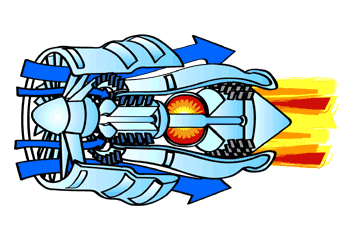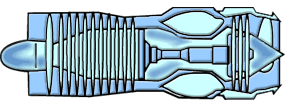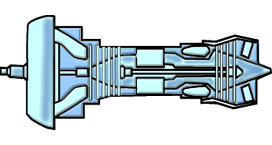What is Aeronautics? | Dynamics
of Flight | Airplanes | Engines
| History of Flight | What
is UEET?
Vocabulary | Fun
and Games | Educational Links | Lesson
lans | Site Index | Home
How does a jet engine work?
|
|
NEW!
"How a Jet Engine Works" video.
We take for granted how easily a plane weighing over half
a million pounds lifts off the ground with such ease. How does it happen?
The answer is simple. It's engines.
Let Theresa Benyo of NASA Glenn Research Center explain
more...
As featured on NASA's
Destination Tomorrow.
|
Jet engines move the airplane forward with a great force that is produced by
a tremendous thrust and causes the plane to fly very fast.
All jet engines, which are also called
gas turbines,
work on the same principle. The engine sucks air in at the front with a fan.
A compressor raises the pressure of the air. The compressor is made
with many blades attached to a shaft.
The blades spin at high speed and compress or squeeze the air.
The compressed
air is then sprayed with fuel and an electric spark lights the mixture. The
burning gases expand and blast out through the nozzle, at the back of the engine.
As the jets of gas shoot backward, the engine and the aircraft are thrust forward.
As the hot air is going to the nozzle, it passes through another group of blades
called the turbine. The turbine is attached to the same shaft as the compressor.
Spinning the turbine causes the compressor to spin.
The image below shows how the air flows through the engine. The air goes through
the core of the engine as well as around the core. This causes some of the air
to be very hot and some to be cooler. The cooler air then mixes with the hot
air at the engine exit area.

This is a picture of how the air flows through an engine
What is Thrust?
Thrust
is the forward force that
pushes the engine and, therefore, the airplane forward. Sir
Isaac Newton discovered that for "every action there is an equal
and opposite reaction." An engine uses this principle. The engine takes
in a large volume of air. The air is heated and compressed and slowed down.
The air is forced through many spinning blades. By mixing this air with jet
fuel, the temperature of the air can be as high as three thousand degrees. The
power of the air is used to turn the turbine. Finally, when the air leaves,
it pushes backward out of the engine. This causes the plane to move forward.
Parts of a Jet Engine

Fan -
The fan is the first component in a
turbofan. The large spinning fan sucks in large quantities of air. Most blades
of the fan are made of titanium. It then speeds this air up and splits it into
two parts. One part continues through the "core" or center of the engine, where
it is acted upon by the other engine components.
The second part "bypasses" the core of the engine. It goes through a duct
that surrounds the core to the back of the engine where it produces much of
the force that propels the airplane forward. This cooler air helps to quiet
the engine as well as adding thrust to the engine.
Compressor -
The compressor is the first
component in the engine core. The compressor is made up of fans with many blades
and attached to a shaft. The compressor squeezes the air that enters it into
progressively smaller areas, resulting in an increase in the air pressure. This
results in an increase in the energy potential of the air. The squashed air
is forced into the combustion chamber.
Combustor -
In the combustor the air is mixed
with fuel and then ignited. There are as many as 20 nozzles to spray fuel into
the airstream. The mixture of air and fuel catches fire. This provides a high
temperature, high-energy airflow. The fuel burns with the oxygen in the compressed
air, producing hot expanding gases. The inside of the combustor is often made
of ceramic materials to provide a heat-resistant chamber. The heat can reach
2700°.
Turbine -
The high-energy airflow coming
out of the combustor goes into the turbine, causing the turbine blades to rotate.
The turbines are linked by a shaft to turn the blades in the compressor and
to spin the intake fan at the front. This rotation takes some energy from the
high-energy flow that is used to drive the fan and the compressor. The gases
produced in the combustion chamber move through the turbine and spin its blades.
The turbines of the jet spin around thousands of times. They are fixed on shafts
which have several sets of ball-bearing in between them.
Nozzle -
The nozzle is the exhaust duct of
the engine. This is the engine part which actually produces the thrust for the
plane. The energy depleted airflow that passed the turbine, in addition to the
colder air that bypassed the engine core, produces a force when exiting the
nozzle that acts to propel the engine, and therefore the airplane, forward.
The combination of the hot air and cold air are expelled and produce an exhaust,
which causes a forward thrust.
The nozzle may be preceded by a mixer,
which combines the high temperature air coming from the engine core with the
lower temperature air that was bypassed in the fan. The mixer helps to make
the engine quieter.
The First Jet Engine - A
Short History of Early Engines
Sir Isaac Newton in the 18th century was the
first to theorize that a rearward-channeled explosion could propel a machine
forward at a great rate of speed. This theory was based on his third law of
motion. As the hot air blasts backwards through the nozzle the plane moves forward.
Henri Giffard built an airship which was powered
by the first aircraft engine, a three-horse power steam engine. It was very
heavy, too heavy to fly.
In 1874, Felix de Temple, built a monoplane
that flew just a short hop down a hill with the help of a coal fired steam engine.
Otto Daimler, in the late 1800's invented
the first gasoline engine.
In 1894, American Hiram Maxim
tried to power his triple biplane with two coal fired steam engines. It only
flew for a few seconds.
The early steam engines were powered by heated coal and were generally much
too heavy for flight.
American Samuel Langley made a model airplanes
that were powered by steam engines. In 1896, he was successful in flying an
unmanned airplane with a steam-powered engine, called the Aerodrome.
It flew about 1 mile before it ran out of steam. He then tried to build a full
sized plane, the Aerodrome A, with a gas powered engine. In 1903, it
crashed immediately after being launched from a house boat.
In 1903, the Wright Brothers
flew, The Flyer, with a 12 horse power gas powered
engine.
From 1903, the year of the Wright Brothers first flight, to the late 1930s
the gas powered reciprocating internal-combustion engine with a propeller was
the sole means used to propel aircraft.
It was Frank Whittle, a British pilot,
who designed and patented the first turbo jet engine in 1930.
The Whittle engine first flew successfully
in May, 1941. This engine featured a multistage compressor, and a combustion
chamber, a single stage turbine and a nozzle.
At the same time that Whittle was working in England,
Hans von Ohain
was working on a similar design in Germany. The first airplane to successfully
use a gas turbine engine was the German
Heinkel He 178, in August, 1939. It was the world's first turbojet powered
flight.
General Electric built the first American jet engine for the US Army Air Force
jet plane . It was the XP-59A experimental aircraft that first flew in October, 1942.
Types of Jet Engines
Turbojets
The basic idea of the
turbojet engine
is simple. Air taken in from an opening
in the front of the engine is compressed to 3 to 12 times its original pressure
in compressor. Fuel is added to the air and burned in a combustion chamber to
raise the temperature of the fluid mixture to about 1,100°F to 1,300°
F. The resulting hot air is passed through a turbine, which drives the compressor.
If the turbine and compressor are efficient, the pressure at the turbine discharge
will be nearly twice the atmospheric pressure, and this excess pressure is sent
to the nozzle to produce a high-velocity stream of gas which produces a thrust.
Substantial increases in thrust can be obtained by employing an
afterburner.
It is a second combustion chamber positioned after the turbine and before the
nozzle. The afterburner increases the temperature of the gas ahead of the nozzle.
The result of this increase in temperature is an increase of about 40 percent
in thrust at takeoff and a much larger percentage at high speeds once the plane
is in the air.
The turbojet engine is a reaction engine. In a reaction engine, expanding gases
push hard against the front of the engine. The turbojet sucks in air and compresses
or squeezes it. The gases flow through the turbine and make it spin. These gases
bounce back and shoot out of the rear of the exhaust, pushing the plane forward.

Picture of Turbojet Engine
Turboprops
A
turboprop engine
is a jet engine attached to a propeller. The turbine at
the back is turned by the hot gases, and this turns a shaft that drives the
propeller. Some small airliners and transport aircraft are powered by turboprops.
Like the turbojet, the turboprop engine consists of a compressor, combustion
chamber, and turbine, the air and gas pressure is used to run the turbine, which
then creates power to drive the compressor. Compared with a turbojet engine,
the turboprop has better propulsion efficiency at flight speeds below about
500 miles per hour. Modern turboprop engines are equipped with propellers that
have a smaller diameter but a larger number of blades for efficient operation
at much higher flight speeds. To accommodate the higher flight speeds, the blades
are scimitar-shaped with swept-back leading edges at the blade tips. Engines
featuring such propellers are called propfans.

Picture of turboprop engine
Turbofans
A
turbofan engine
has a large fan at the front, which sucks in
air. Most of the air flows around the outside of the engine, making it quieter
and giving more thrust at low speeds. Most of today's airliners are powered
by turbofans. In a turbojet all the air entering the intake passes through the
gas generator, which is composed of the compressor, combustion chamber, and
turbine. In a turbofan engine only a portion of the incoming air goes into the
combustion chamber. The remainder passes through a fan, or low-pressure compressor,
and is ejected directly as a "cold" jet or mixed with the gas-generator exhaust
to produce a "hot" jet. The objective of this sort of bypass system is to increase
thrust without increasing fuel consumption. It achieves this by increasing the
total air-mass flow and reducing the velocity within the same total energy supply.
Picture of Turbofan Engine
Turboshafts
This is another form of gas-turbine engine that operates much like a turboprop
system. It does not drive a propellor. Instead, it provides power for a helicopter
rotor. The turboshaft engine is designed so that the speed of the helicopter
rotor is independent of the rotating speed of the gas generator. This permits
the rotor speed to be kept constant even when the speed of the generator is
varied to modulate the amount of power produced.

Picture of Turboshaft Engine
Ramjets
The
ramjet is the
most simple jet engine and has no moving parts. The speed of the jet "rams"
or forces air into the engine. It is essentially a turbojet in which rotating
machinery has been omitted. Its application is restricted by the fact that its
compression ratio depends wholly on forward speed. The ramjet develops no static
thrust and very little thrust in general below the speed of sound. As a consequence,
a ramjet vehicle requires some form of assisted takeoff, such as another aircraft.
It has been used primarily in guided-missile systems. Space vehicles use this
type of jet.

Picture of Ramjet Engine
Back to top
What is Aeronautics?
| Dynamics of Flight | Airplanes
| Engines | History
of Flight | What is UEET?
Vocabulary | Fun
and Games | Educational Links | Lesson
Plans | Site Index | Home
